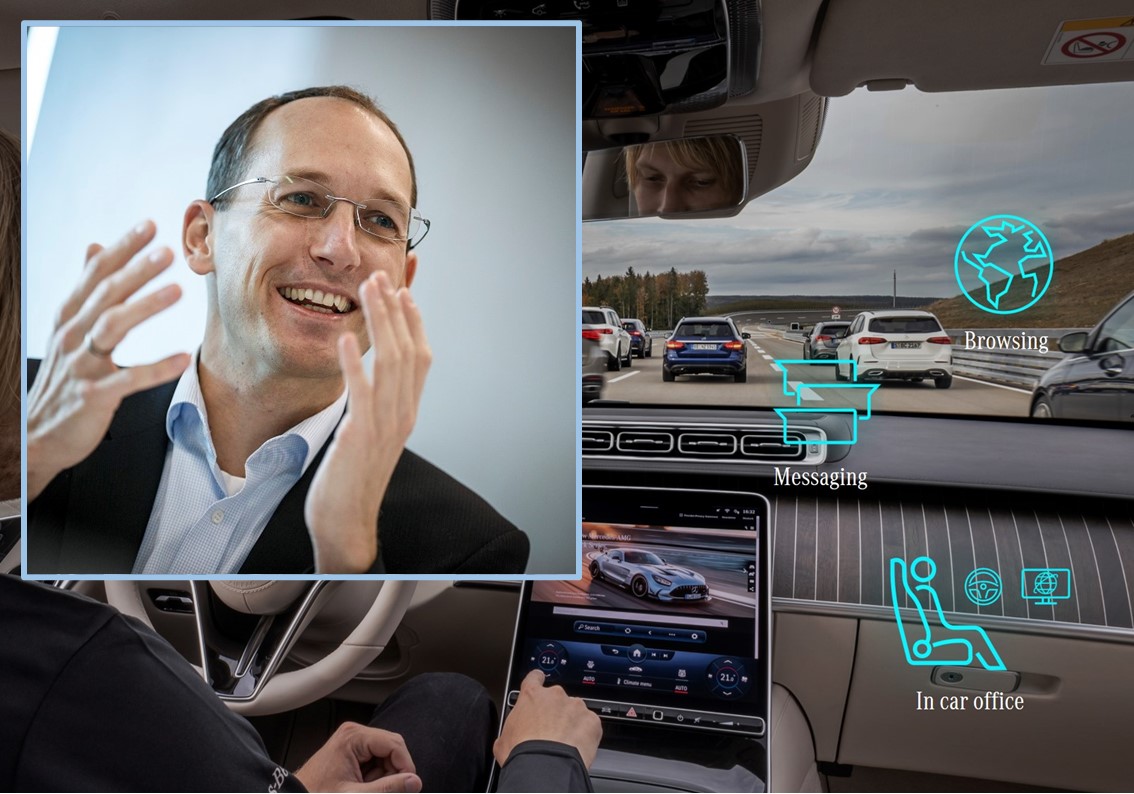More safety features for the car of the future – how are driver assistance systems developed?

Munich, 30 March 2023
For years we have been hearing of progress and setbacks in, as well as facts and myths about, automated driving. At acatech am Dienstag, which took place on 21 March in partnership with vhs.wissen live, Christoph von Hugo (Daimler AG) gave the audience an overview of the five levels of automation – from zero automation right up to driverless vehicles. Giving selected examples, he informed the more than 350 participants of the virtual event of the current state of the art and gave an outlook on future possibilities.
Mobility of the future has to be adaptable, much more resilient and reflect changed living environments, said the newly elected acatech President Thomas Weber in his welcoming speech. The focus must remain on the objectives of environmental and climate policy and the possibilities afforded by digitalisation must be used to solve issues relating to the future. The mobility system of the future has to be in line with needs as well as sustainable and safe – without losing sight of prosperity and innovation capacity.
The biggest motivation to press ahead with the development of driver assistance systems and automated driving is to make the roads safer, said Christoph von Hugo, Head of Active Safety at Daimler AG, in his opening. In addition, the greater the automation the greater the chance of enhanced comfort, more efficient use of people’s time, more sustainable traffic flows and, in the long term, the transformation of mobility.
The road to automated driving: more evolution than revolution
The road to automated driving is a long one and was more of an evolution than a revolution, said Christoph von Hugo. Passive safety in vehicles has its origins in the 1950s with the invention of the crumple zone in the car. Active safety, which is supposed to help avoid accidents in the first place, made great strides with the “Antilock Braking System” (ABS) at the end of the 1970s. The first electronic assistance systems came along in the 1990s. Since then, the pace of innovation has steadily increased thanks to the technological possibilities. Yet it’s important, he said, that however ambitious we may be, we must not be too hasty. We must introduce the systems with an eye to safety, control and customer benefit. Development is always centred on the human.
With all systems, what’s important is supporting drivers, not infantilising them – hence the term “driver assistance systems”. In the case of safety systems such as Active Brake Assist, the endeavour is always to enable the driver to perform the task of driving as best possible. An escalation strategy is in place. First the driver is warned in time of an emergency braking situation. In the next step, the system itself cuts in.
Overview of the levels of automation
Christoph von Hugo then went into the six levels of driving automation as defined by the Society of Automotive Engineers (SAE). At Level 0 there is zero automation and Level 1 is defined as “assisted”. From there the level of automation gradually increases up to Level 5, which is defined as full driving automation; that is, “driverless”.
In Level 1, driver assistance systems (e.g. using radar and camera sensors) provide prolonged support either with acceleration and braking (called longitudinal control), and steering (called lateral control), but the driver remains fully in control. Level 1 features include Active Distance Assist and Traffic Sign Assist. The latter recognises speed limit signs, no overtaking signs and stop signs and warns the driver if they are approaching a red light too fast. Attention Assist gives audible and visual warnings if it detects increasing signs of drowsiness or inattention. Car-to-X Communication enables vehicles to share information with other vehicles; for instance, to warn of danger spots around bends and over brows of hills. In addition, modern headlight systems not only light the road better but can even project symbols onto the road to support the driver.
Automation Level 2 provides longitudinal and lateral control in tandem; that is, active distance and steering support. In addition to “Active Distance Assist”, cars have “Active Steering Assist”: this feature supports drivers with lane keeping. In other words, it helps them steer but they must keep their hands on the steering wheel. Based on various sensor data processed on a central control unit, the drive train and steering are controlled, providing the driver with optimal support and enhancing comfort and safety. With the smart use of map data, the driver’s speed can also be adjusted ahead of bends, crossroads or roundabouts. Active Lane Change Assist provides support when changing lanes; for example, to initiate overtaking when coming up on a slower road user. Remote Parking Assist is another Level 2 system, which enables the driver to control the parking manoeuvre from outside the car.
Level 3 is the first level at which drivers can disengage from the act of driving in certain situations, such as in a traffic jam on the motorway. Among other things, LiDAR (a laser scanner that scans the area in front of the car, supplementing the radar sensor and camera data) is required for this to work. In addition, there is a moisture sensor in the wheel well, an ultra-precise positioning system as well as redundant steering and braking actuators and a redundant on-board electrical system.
At Level 3, drivers can give their attention to certain other activities while travelling, such as working, surfing the internet or watching movies, while the vehicle monitors the traffic around them. However, the driver cannot sleep as they must remain aware and take over driving immediately if necessary. Such highly automated driving is currently only possible on motorways if the driver in front is moving at a speed of up to 60 km/h and if the road markings are clear. This is to ensure maximum safety with this technology, which is now available in standard vehicles for the first time. It cannot be used at present in the dark or in poor weather.
At Level 4, there is a another big step up in the degree of complexity: this is the first level at which a vehicle can travel without a driver but is limited to certain routes and precisely defined conditions. The only standard product for private consumers at present is an integrated parking system, which can be used in specially equipped car parks. It enables the driver to drop the car off in a designated zone and collected it there later. On command, the vehicle parks itself without a driver.
Level 5 is the highest level of automation: at this level the vehicle is able to handle all driving situations without a driver. Some people refer to vehicles with this level of automation as robotaxis. Level 5 is an area of autonomous driving that has seen huge progress in recent years.
In general, higher degrees of driving automation will become increasingly common, said Christoph von Hugo. Already automation level 3 features enable drivers to make better use of their time stuck in traffic on the motorway. These and other advantages will, he said, ultimately lead to a breakthrough in automated driving technology in the future.




